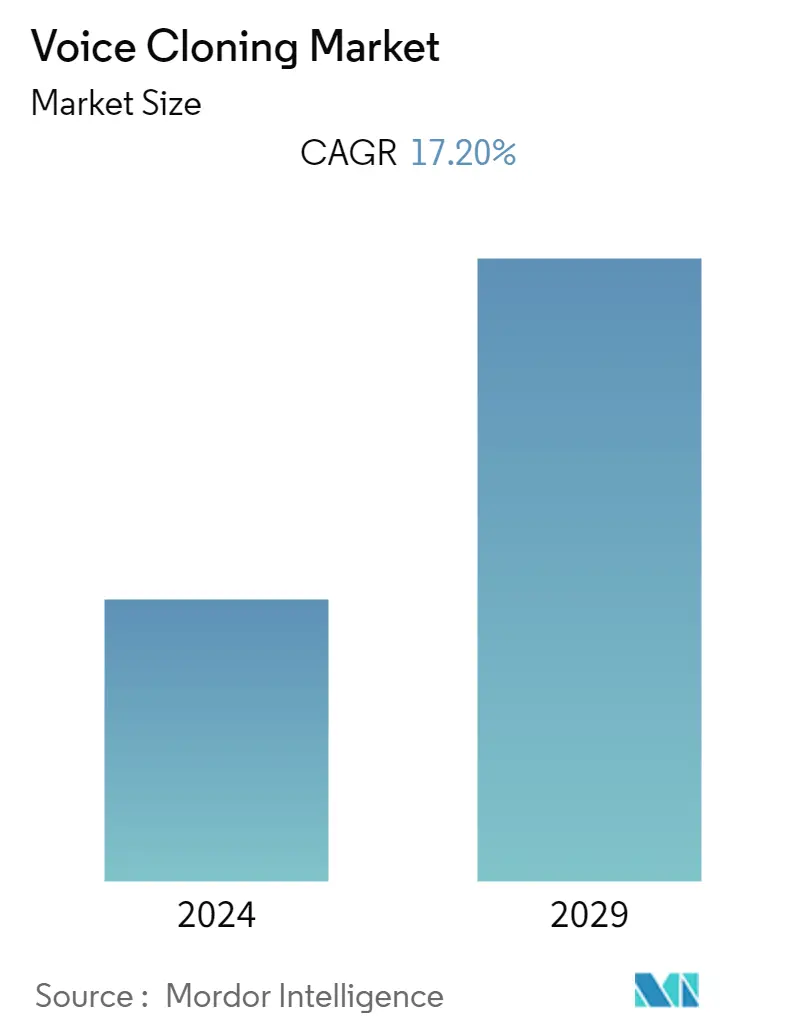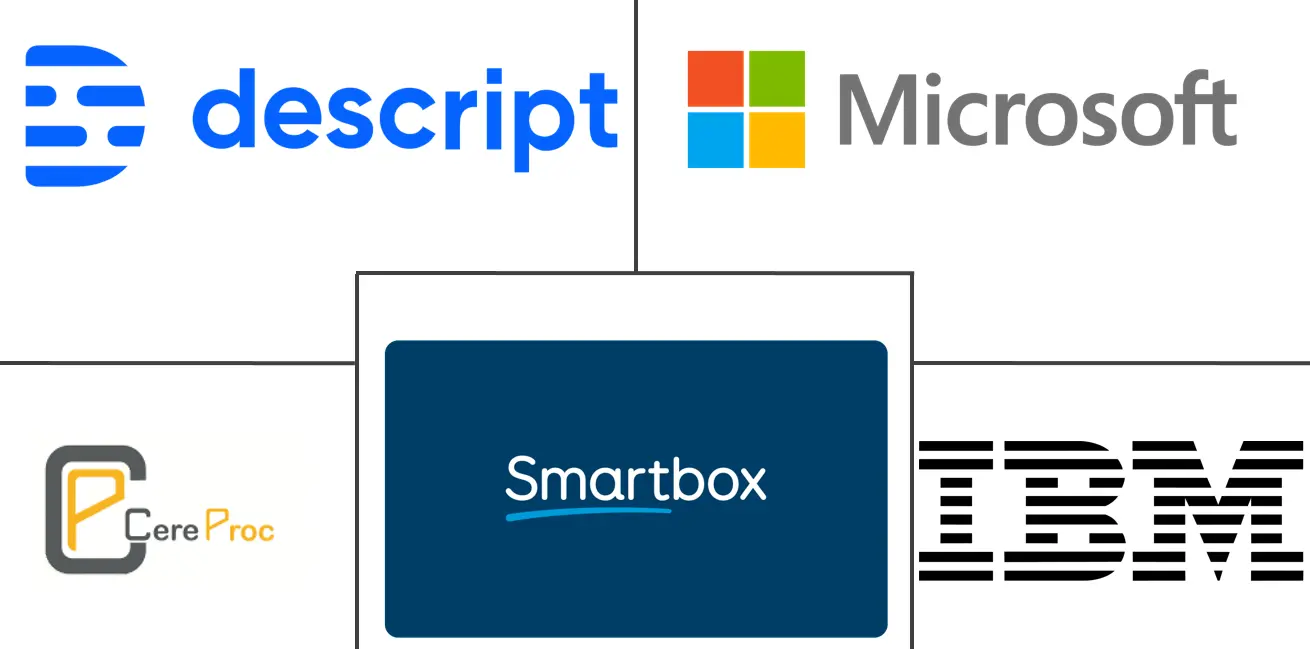Market Size of Voice Cloning Industry

| Study Period | 2019 - 2029 |
| Base Year For Estimation | 2023 |
| CAGR | 17.20 % |
| Fastest Growing Market | Asia-Pacific |
| Largest Market | North America |
| Market Concentration | Medium |
Major Players
*Disclaimer: Major Players sorted in no particular order |
Voice Cloning Market Analysis
The voice cloning market is expected to grow at a CAGR of 17.2% during the forecast period. Voice cloning is the process of synthesizing someone's voice.The voice-cloning solutions and services allow users to generate a computerized version of their voice. These solutions synthesize someone's voice from a few audio samples. Voice cloning is done with the help of artificial intelligence (AI) and machine learning algorithms.
- Enterprises focus on enhancing their customers' experiences by introducing a familiar voice to their products and services. By using these solutions, businesses can form significant long-term relationships with customers by providing them with a considerably better customer experience. Technology providers are also adopting cutting-edge technologies for developing efficient voice cloning solutions. For example, in November last year, The Noddle System, a tool created by Voxello, enabled hospital patients with speech disorders or impairments to contact and converse with their family members and caregivers. Using a microphone, Tenor.ai listens to discussions between patients and doctors in the exam room.
- A voice cloning procedure typically needs a couple of hours of recorded speech to build a dataset and then use the dataset to train a new model. With the growing adoption of AI and machine learning solutions, developers are working hard to shorten the time it takes to complete a voice cloning process.
- However, the malicious ways in which voice cloning methods can be misused are expected to impede the growth of this market. As voice cloning technology can generate fake audio clips that can be manipulated to spread false insights, it has become a significant matter of concern. While the applications for voice cloning technologies, like synthetic voice and speech-to-text, are still expanding, others highlight the technology's moral dilemmas. For instance, a podcast of a conversation between Steve Jobs and Joe Rogan was published by Podcast.ai. The podcast sounds like it features both people's actual voices; however, it was entirely produced by AI.
- Voice cloning companies are also working on making deep fake detection tools so that voice cloning technology isn't abused as much.For instance, in January this year, Microsoft's latest venture into artificial intelligence was VALL-E. This text-to-speech model uses transformers and can "recreate any voice from a three-second sample clip." According to cybersecurity experts, it may be used to launch more convincing phishing attempts and disseminate false information without the proper safeguards.
- At the time of the COVID-19 pandemic, the requirement for digital education platforms kept increasing across the world. When the pandemic was declared in March, the United States sprang into action, and offices, schools, and public areas were shut down. The need for the education system to go online, from K-12 to college, was enormous. E-learning organizations were taking advantage of the opportunity to conduct uninterrupted online classes through voice cloning technology. For example, Voice.com's voice actors did more than 45,000 voice cloning projects for North America's educational institutions.
Voice Cloning Industry Segmentation
Voice cloning is the process of duplicating a real person's unique voice by using a computer to generate speech and artificial intelligence.
The Voice Cloning Market is Segmented by Deployment Type (On-Premise, Cloud), End-user Verticals (IT & Telecommunication, BFSI, Educational Institutions, Healthcare, Travel & Tourism), and Geography (North America (United States, Canada), Europe (Germany, UK, France, Spain, and Rest of Europe), Asia Pacific (China, Japan, India, Australia, and Rest of Asia-Pacific), and Rest of the World). The market sizes and forecasts are provided in terms of value (USD million) for all the above segments.
| Deployment Type | |
| On-Premise | |
| Cloud |
| End-user Verticals | |
| IT & Telecommunication | |
| BFSI | |
| Educational Institutions | |
| Healthcare | |
| Travel & Tourism | |
| Others (Media & Entertainment, Retail) |
| Geography | |||||||
| |||||||
| |||||||
| |||||||
| Rest of the World |
Voice Cloning Market Size Summary
The voice cloning market is poised for significant expansion, driven by advancements in artificial intelligence and machine learning technologies. This market encompasses solutions that synthesize a person's voice from audio samples, enabling businesses to enhance customer experiences by integrating familiar voices into their products and services. The technology is gaining traction across various sectors, including education, healthcare, and media, as it offers innovative applications such as voice banking and speech generation for individuals with speech impairments. Despite its potential, the market faces challenges due to concerns over misuse, such as the creation of fake audio clips for fraudulent purposes. This has prompted the development of deep fake detection tools and regulatory measures to mitigate risks.
In North America, the market's growth is bolstered by the presence of numerous technology providers and government initiatives aimed at fraud prevention. Companies are actively engaging in strategic partnerships and technological innovations to maintain a competitive edge. The market is moderately competitive, with key players like IBM, Microsoft, and CereProc focusing on research and development to expand their offerings. Additionally, collaborations, such as those between Stats Perform and Veritone, highlight the integration of voice cloning technology in various applications, from sports commentary to customer service. As the demand for voice cloning solutions continues to rise, the market is expected to evolve, balancing innovation with ethical considerations and regulatory compliance.
Voice Cloning Market Size - Table of Contents
-
1. MARKET INSIGHTS
-
1.1 Market Overview
-
1.2 Industry Attractiveness - Porter's Five Forces Analysis
-
1.2.1 Threat of New Entrants
-
1.2.2 Bargaining Power of Buyers/Consumers
-
1.2.3 Bargaining Power of Suppliers
-
1.2.4 Threat of Substitute Products
-
1.2.5 Intensity of Competitive Rivalry
-
-
-
2. MARKET SEGMENTATION
-
2.1 Deployment Type
-
2.1.1 On-Premise
-
2.1.2 Cloud
-
-
2.2 End-user Verticals
-
2.2.1 IT & Telecommunication
-
2.2.2 BFSI
-
2.2.3 Educational Institutions
-
2.2.4 Healthcare
-
2.2.5 Travel & Tourism
-
2.2.6 Others (Media & Entertainment, Retail)
-
-
2.3 Geography
-
2.3.1 North America
-
2.3.1.1 United States
-
2.3.1.2 Canada
-
-
2.3.2 Europe
-
2.3.2.1 Germany
-
2.3.2.2 UK
-
2.3.2.3 France
-
2.3.2.4 Spain
-
2.3.2.5 Rest of Europe
-
-
2.3.3 Asia Pacific
-
2.3.3.1 China
-
2.3.3.2 Japan
-
2.3.3.3 India
-
2.3.3.4 Australia
-
2.3.3.5 Rest of APAC
-
-
2.3.4 Rest of the World
-
-
Voice Cloning Market Size FAQs
What is the current Voice Cloning Market size?
The Voice Cloning Market is projected to register a CAGR of 17.20% during the forecast period (2024-2029)
Who are the key players in Voice Cloning Market?
IBM Corporation, Microsoft Corporation, Smartbox Assistive Technology Ltd, Descript, Inc. and CereProc Ltd. are the major companies operating in the Voice Cloning Market.

